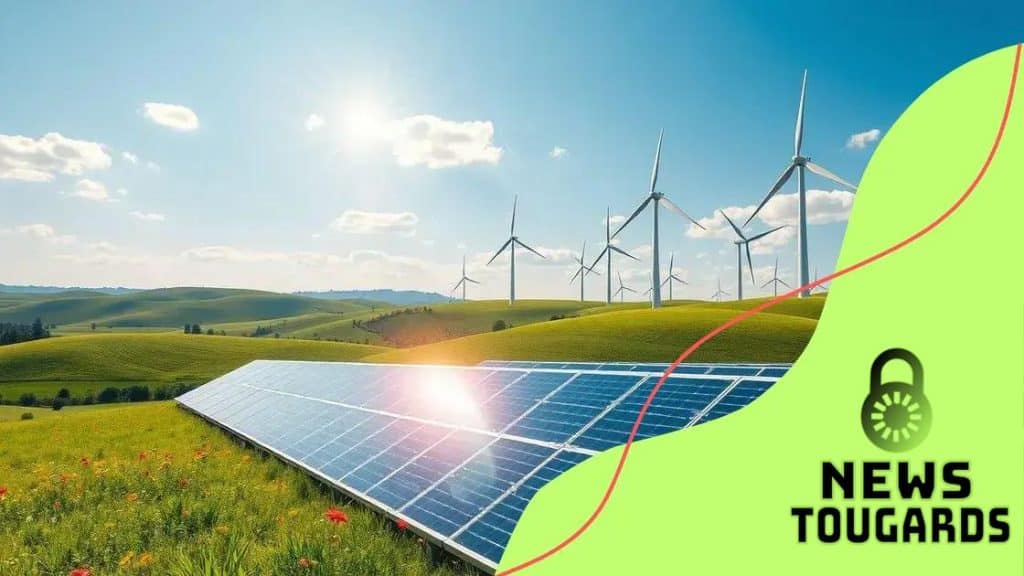Advances in green energy tech and its economic impact

Advances in green energy tech significantly impact the economy by creating jobs, reducing energy costs, and promoting energy independence, while also facing challenges such as high initial investment and regulatory hurdles.
Advances in green energy tech are changing how we think about our environment and economy. Ever wondered how these innovations impact everyday life? Let’s dive in and explore!
The latest innovations in green energy technology
With the world increasingly focused on sustainability, the latest innovations in green energy technology are becoming crucial. These breakthroughs not only help reduce carbon footprints but also introduce new ways of harnessing natural resources effectively.
Solar Power Advancements
Recent developments in solar technology have improved efficiency and reduced costs. For example, the introduction of bifacial solar panels allows energy capture from both sides, increasing overall output. Furthermore, perovskite solar cells are emerging as a potential game-changer by offering high efficiency at lower production costs.
Wind Energy Innovations
Wind energy has also seen remarkable advancements. New turbine designs can now operate at lower wind speeds, maximizing energy capture even in less favorable conditions. Additionally, innovations like floating wind farms expand the potential for wind energy generation further offshore, where winds are typically stronger and more consistent.
- Increased turbine heights for better performance
- Advanced materials leading to lighter and stronger turbine blades
- Enhanced data analytics for optimal energy production
Battery storage technology plays a vital role in the integration of renewable energy sources. Recent breakthroughs in lithium-sulfur and solid-state batteries promise to increase energy density and longevity, making them more effective for storing the energy produced by solar and wind technologies. This means more reliable power supply, even when the sun isn’t shining or the wind isn’t blowing.
Hydrogen Fuel Innovations
Hydrogen is gaining attention as a clean energy carrier. Innovations in electrolyzer technology are reducing costs and increasing the efficiency of hydrogen production from renewable sources. This adoption of hydrogen fuel cells in transportation could reshape how we think of clean mobility.
- Improved electrolyzer designs for better efficiency
- Use of renewable energy in hydrogen production
- Greater focus on infrastructure development for hydrogen distribution
As we continue to innovate, the synergy between different green technologies is becoming clear. Integrating these renewable sources alongside smart grid technologies and energy management systems can help create a more resilient and sustainable energy future.
Economic benefits of renewable energy adoption
The economic benefits of renewable energy adoption are vast and growing. As countries embrace greener technologies, they not only protect the planet but also enhance their economic landscapes.
Job Creation
Switching to renewable energy sources creates numerous job opportunities. From manufacturing solar panels to maintaining wind turbines, the sector is expanding rapidly. The International Renewable Energy Agency (IRENA) reports that millions of jobs could be created worldwide by investing in clean energy technologies.
- Installation and maintenance jobs in solar and wind sectors
- Research and development roles for innovative energy solutions
- Local manufacturing opportunities for energy equipment
With these roles, communities benefit from new employment options that often come with well-paying wages. As these jobs grow, they contribute to local economies, bolstering spending and stimulating growth.
Energy Independence
Renewable energy leads to greater energy independence. By harnessing local resources, countries can reduce their reliance on imported fossil fuels. This shift not only stabilizes energy prices but also enhances national security. As nations invest in technologies like wind and solar, they build resilience against price volatility in the global energy market.
Another significant advantage is that renewables can be generated locally, which means energy production adapts well to regional needs. This localization reduces the need for extensive energy transportation systems, further decreasing costs.
Cost Savings
The initial investment in renewable energy technologies might seem high, but over time, they lead to substantial cost savings. The operational costs of renewable resources, like wind and solar, are significantly lower than fossil fuels. Additionally, as technology advances, prices continue to drop.
- Reduced electricity bills for consumers
- Lower long-term energy prices as technology improves
- Tax incentives and subsidies for renewable energy projects
Energy efficiency improvements and the scalability of renewable projects mean more sustainable financial futures for both businesses and consumers.
In summary, renewable energy adoption offers extensive economic benefits. By generating jobs, ensuring energy independence, and providing cost savings, the shift to renewables positions economies for a sustainable and prosperous future.
How green technologies impact job creation

How green technologies impact job creation is a vital topic in the transition to a more sustainable economy. As the world shifts towards renewable energy sources and eco-friendly practices, job markets are evolving rapidly.
Expanding Industries
Green technologies have led to the creation of entirely new industries that focus on sustainability and energy efficiency. For instance, the solar energy sector has seen a massive boom in job opportunities. Many are now involved in the production, installation, and maintenance of solar panels.
- Manufacturing jobs related to solar equipment
- Installation positions for residential and commercial solar systems
- Roles in solar project management and consulting
Similarly, wind energy is rising. As more wind farms are built, workers are needed to ensure their construction and ongoing operations. This shift not only offers jobs but also encourages local economies to flourish.
Job Complexity and Skills
Jobs in green technologies often require specialized training and skills. This demand is driving educational programs that prepare the workforce for a future focused on sustainability. Community colleges and technical schools are now offering courses specifically aimed at green job training.
Furthermore, with advancements in technology, existing jobs are evolving. Traditional roles in energy and construction are adapting to include renewable practices and sustainability strategies. This means that many workers are gaining new skills, which enhances their employability.
- Training in energy efficiency and sustainable practices
- Keeping up with new technologies and tools
- Enhanced understanding of environmental impacts
In addition, as companies adopt green practices, they create new roles aimed at sustainability. These can vary from sustainability coordinators to environmental consultants, focusing on reducing waste and promoting eco-friendly efforts. This kind of cross-industry innovation provides stability and growth.
Long-Term Economic Growth
Ultimately, the impact of green technologies on job creation contributes to long-term economic growth. By investing in renewable energy and eco-efficient practices, nations can improve their workforces while securing energy sources and fostering innovation. This holistic growth contributes to a thriving ecological and economic future for everyone.
Challenges in implementing green energy solutions
Implementing green energy solutions comes with several challenges. While the benefits of renewable energy are clear, challenges in implementing green energy solutions can hinder progress and require strategic planning.
High Initial Costs
One of the primary obstacles is the high upfront cost associated with renewable energy projects. Although the long-term savings can be significant, many individuals and businesses struggle to afford initial investments in solar panels or wind turbines. This can delay the adoption of green technologies.
- Financing options may be limited for small businesses.
- Government incentives can sometimes be complicated to navigate.
- Development of infrastructure can be costly and time-consuming.
Understanding and accessing available financial support can help in overcoming these barriers, but it often requires research and planning.
Technology Integration
Integrating new green technologies with existing systems can be challenging. Many businesses may have outdated equipment or infrastructures not designed to support renewable energy solutions. Retrofitting existing systems for compatibility can be expensive and require specialized knowledge.
Additionally, the rapid pace of technological advancements can make it difficult for businesses to keep up, leading to potential obsolescence of newer methods.
- Training employees on new technology is necessary.
- Compatibility issues may arise with current energy systems.
- Constant updates may require ongoing financial resources.
Despite these hurdles, continued innovation is paving the way for solutions that can ease integration challenges.
Regulatory Issues
Another significant challenge is navigating regulatory hurdles related to renewable energy implementation. Policies can vary greatly by region, and new regulations can emerge, making compliance complex for businesses and individuals. These regulations can also impact the feasibility of certain projects.
Ensuring compliance often requires expertise, and staying updated on changes can be burdensome. Without proper guidance, potential projects may face delays or additional costs.
Even with these challenges, collaboration between governments, the private sector, and communities can lead to effective strategies for overcoming them, making the transition to a greener energy future possible.
Future trends in green energy economics
Understanding the future trends in green energy economics is essential as the world moves towards more sustainable practices. The shift to renewable energy is reshaping the economic landscape in numerous ways, creating both opportunities and challenges.
Increased Investment in Renewable Technologies
Investment in green technologies is expected to surge as more companies and governments recognize the long-term benefits. Solar and wind energy projects are leading the way, attracting significant funding. As more capital flows into these sectors, we will see innovation and expansion flourish.
- New methods for energy storage will emerge.
- Investment in infrastructure for electric vehicle charging stations will grow.
- Financial support for research in alternative energy sources will increase.
This influx of investment not only drives economic growth but also leads to job creation in various sectors.
Decentralization of Energy Production
Another trend is the decentralization of energy production. More households and businesses are turning to localized energy solutions like solar panels. This shift allows consumers to generate their own electricity and sell excess power back to the grid.
As a result, consumers gain greater control over their energy use and expenses, leading to reduced utility bills. This decentralization alters traditional energy market dynamics and enhances energy security.
Policy and Regulatory Changes
Future trends will also be influenced by evolving policies and regulations aimed at promoting green energy. Governments worldwide are setting ambitious targets to reduce carbon emissions. These policies encourage the adoption of renewable energy and drive innovation in sustainable practices.
- Incentives for businesses that adopt green technologies are likely to increase.
- Regulations promoting energy efficiency will become more stringent.
- Carbon pricing mechanisms may be implemented to combat pollution.
These regulatory changes may initially pose challenges for traditional energy sectors, but they ultimately pave the way for a cleaner environment and a more sustainable economy.
Emerging Technologies
Innovative technologies play a crucial role in the future of green energy economics. Advances in energy storage solutions, such as high-capacity batteries and smart grids, enhance the reliability of renewable energy sources. Furthermore, breakthroughs in hydrogen fuel technology and energy efficiency will revolutionize how energy is produced and consumed.
The combined effect of these trends signals a shift in the economic paradigm, where sustainability and profitability can coexist. Staying informed about these developments will be key for businesses and individuals looking to thrive in the evolving energy landscape.
FAQ – Frequently Asked Questions about Advances in Green Energy Tech and Its Economic Impact
What are the main benefits of adopting green energy technologies?
Adopting green energy technologies leads to job creation, reduced energy costs, and increased energy independence.
How do renewable energy sources impact job markets?
Renewable energy sources create new jobs in manufacturing, installation, and maintenance, significantly boosting local economies.
What challenges do businesses face when implementing green energy solutions?
Some challenges include high initial costs, technology integration, and navigating regulatory requirements.
What trends are shaping the future of green energy economics?
Trends include increased investment in renewable technologies, decentralization of energy production, and emerging innovative technologies.





